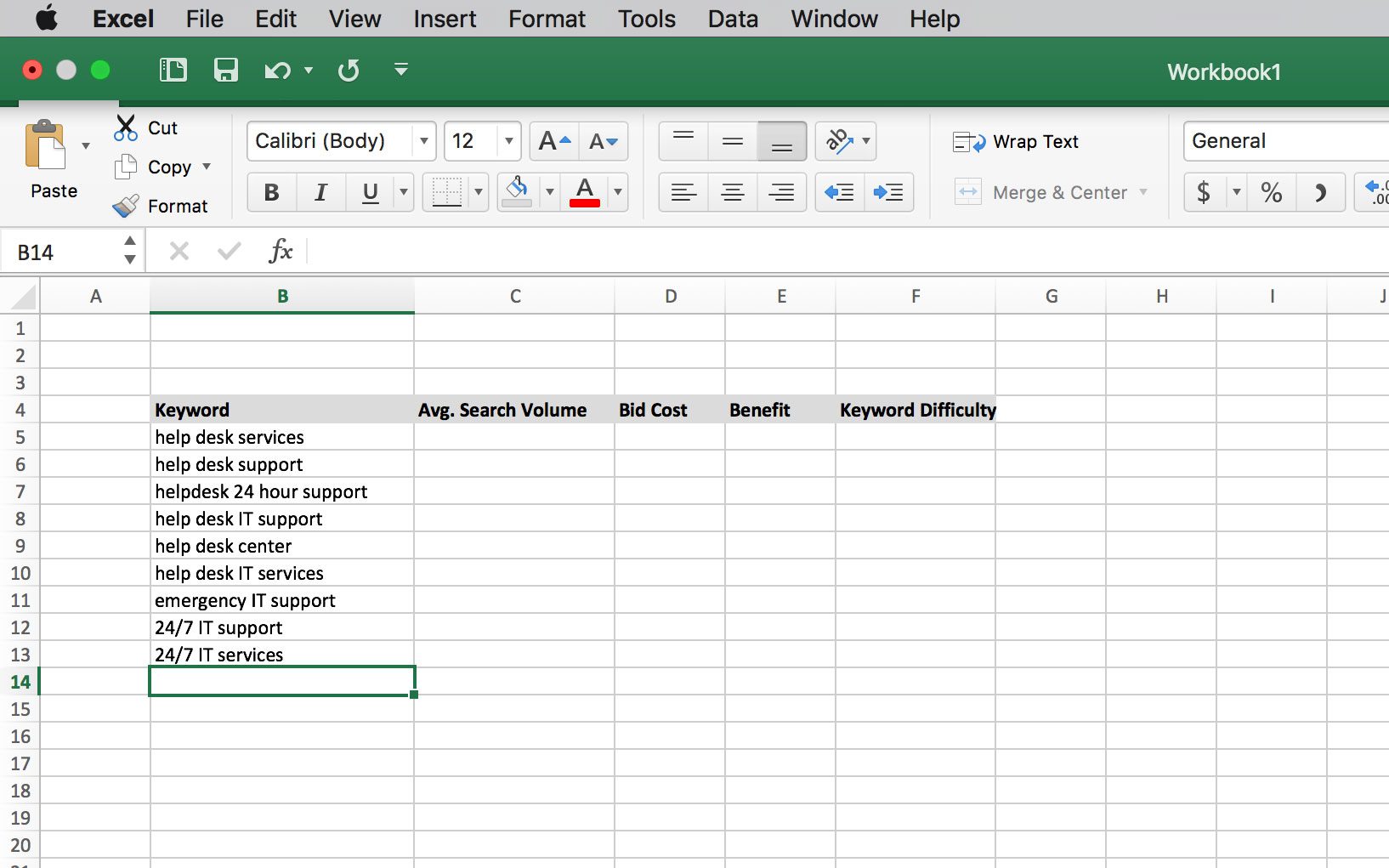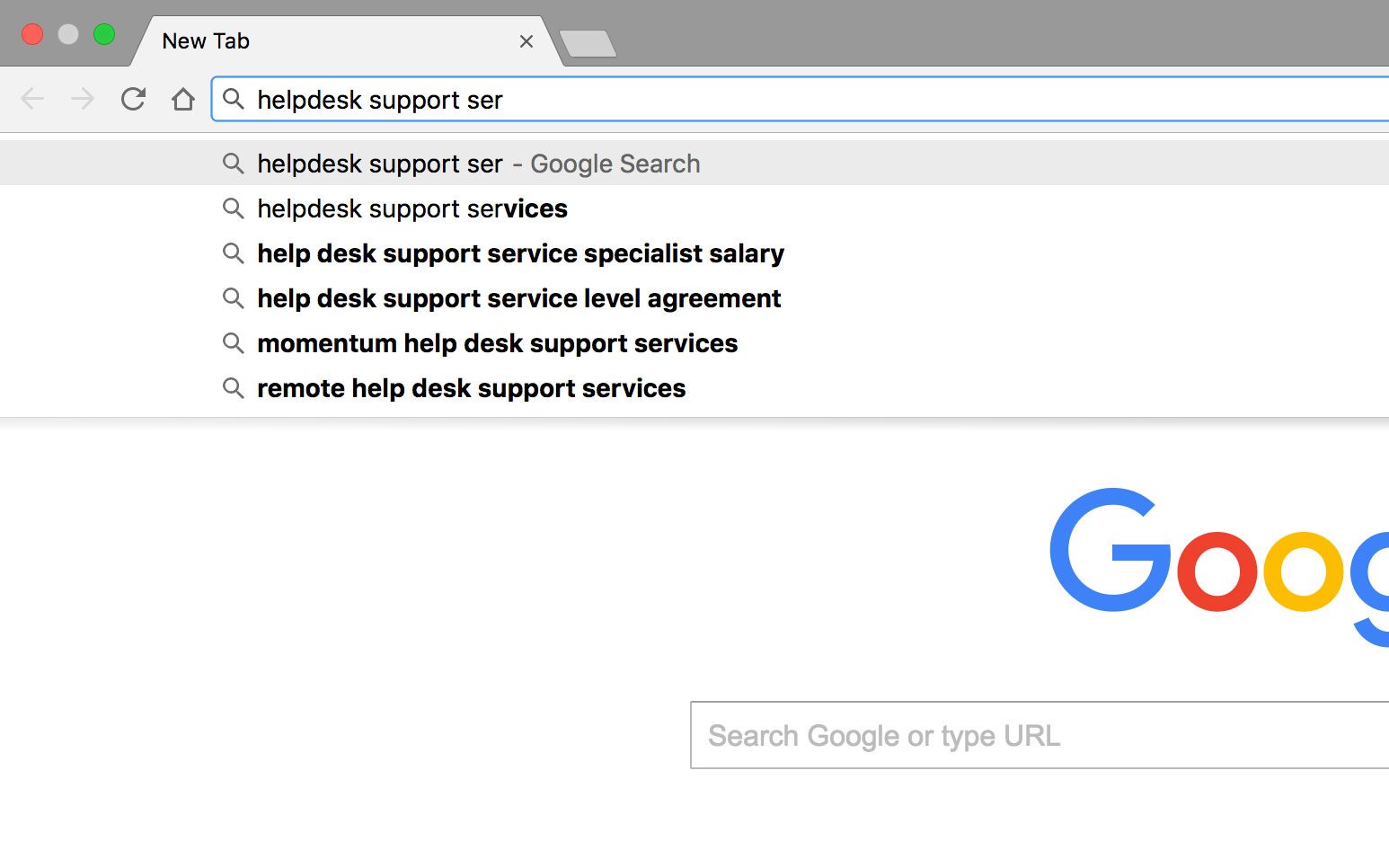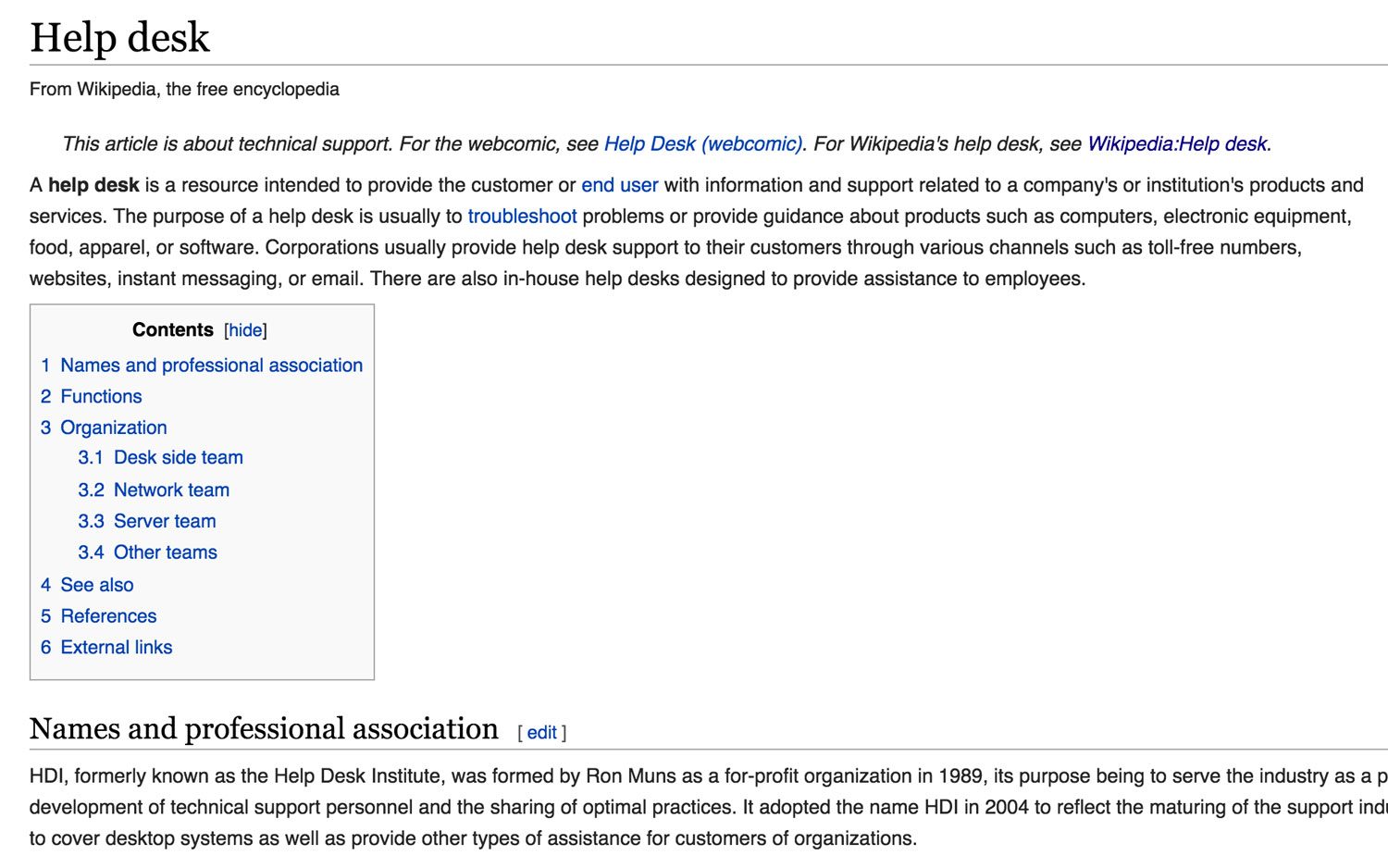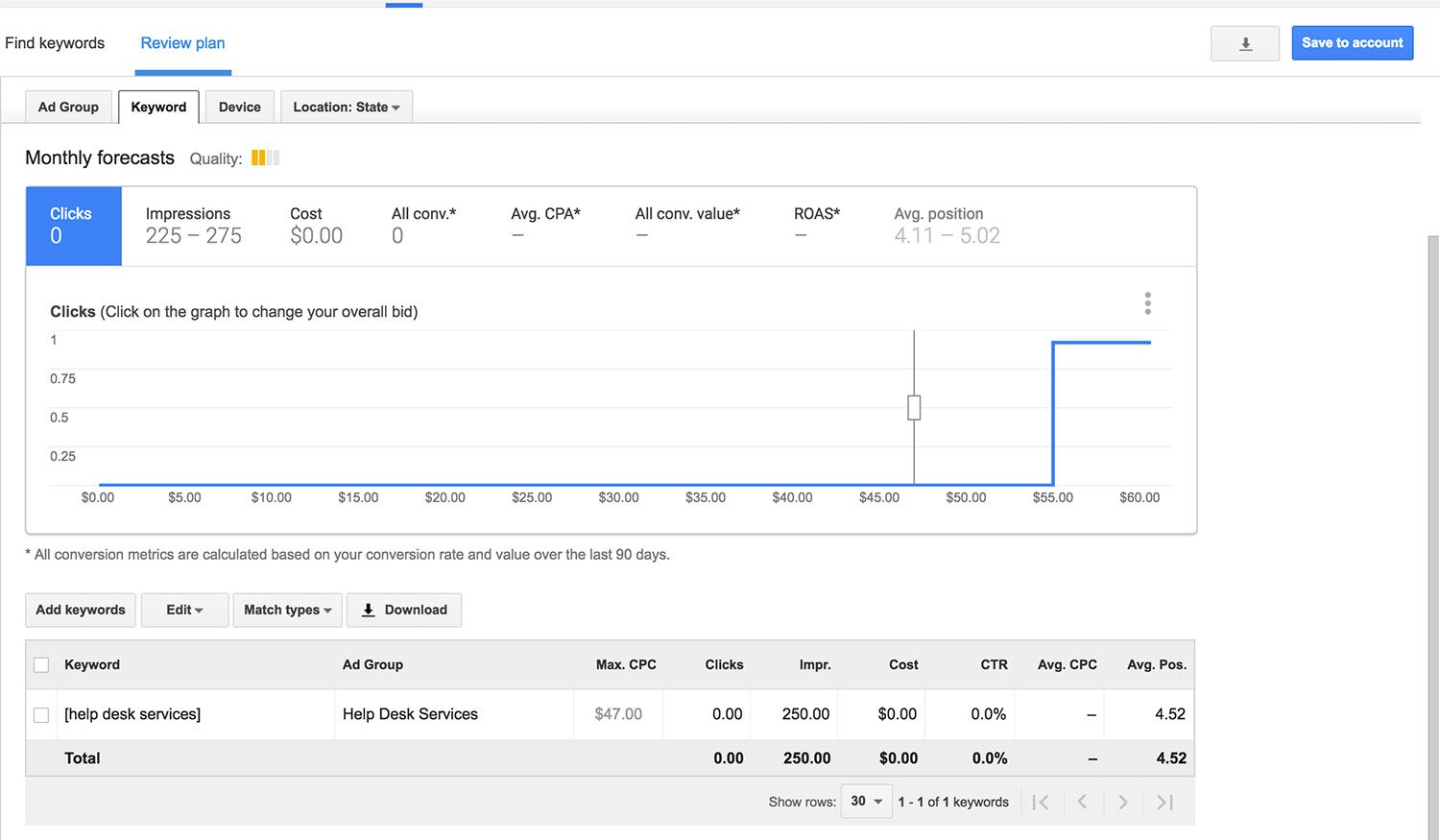Managed IT is a growing industry, and it’s getting more competitive by the day.
More than ever, you need a website that helps people get helpful information when looking for an IT partner. A good keyword strategy can do wonders for helping your business get found.
Every marketer has a different process for researching keywords. Some rely exclusively on data from Google, while others use several different tools to evaluate their options. We feel the best results come from using a combination of buyer insights, thoughtful planning, and thorough research from a few respected tools.
Getting Started
Analyzing keywords is really not that difficult if you have the right tools. The challenging part is making sure you have the right keywords to begin with, and that takes a little work.
Some marketers simply download a list of suggestions on Google Keyword Planner, pick out the ones with the highest search volume, and call it a day. This is a huge mistake. Google Keyword Planner is a valuable tool, but it should never be the only one you use. If you want real results, you have to dig deeper.
Brainstorming Keywords
The key to a successful keyword strategy for IT is getting inside the heads of people who are looking for your services, and a brainstorming session with your team is a good place to start. Sit down with your colleagues and try to come up with every possible phrase people might use to search for your service.

Likewise, you need to determine what this page with your target keyword phrase will accomplish, and what you hope to gain from optimizing its content.
What Is The Page About?
Think about the searcher’s intent and how this page will help them. Are they searching for “helpdesk services” or a post about “how to find a good helpdesk provider?” The purpose of the content itself will help guide you to the language you should research.
Are You Optimizing For Traffic Or Conversions?
SEO Nick makes an interesting point that marketers tend to focus on either optimizing for traffic or for conversions. Whether they realize it or not, most people optimize their pages for traffic, even when the goal is to get people to take a specific action, or “convert.”
Look at the following two queries and guess which user is closer to buying a service:
What do helpdesk services cost?
Helpdesk services in Chicago
A business owner researching “helpdesk service costs” is likely much closer to hiring a specialist, and if your landing page is designed for closing the deal with people who have fallen in love with your solutions and are ready to buy – this might be a good direction to go in.
Think about the goals behind your page and how you can craft the language to attract the right visitor at the right time.
Start A Keyword Research Spreadsheet
Create a template you can use for every keyword research project you do. Everyone has their own preferences regarding which values to put in the columns. I like to put “Keyword” the first column, “Search Volume” in the second, “Bid Cost” in the third, “Benefit” in the fourth, and “Keyword Difficulty” in the fifth. When our research is done, we will create a sixth column that tabulates the overall value of the keyword. Note: We offer a template you can download that follows the steps and calculations outlined in this post.
Brainstorm Ideas With the Team
Once you’ve decided what the purpose of the page will be and how it supports your business goals, it’s time to start putting ideas down on the spreadsheet. Do some green light thinking with your team and write as many variations of the phrase as you can think of.

Try to focus on phrasing your business prospects are likely to use. For instance, “helpdesk services” might be the correct term, but some people might also be searching for “24/7 IT support.” Semantics matter when it comes to marketing, so make sure you get as many options on the spreadsheet as possible.
Tools That Will Help You Find Keywords
You can access several tools online that will give you suggestions on what people are searching for.
Google Auto-Suggest And “Related Searches”
Start typing in your keyword into the Google search bar and see what suggestions drop down, then choose one that looks relevant and see what comes up on the search engine results page (SERP).

Make a note of whether you see a lot relevant content published on your phrase already. Some browser plugins, like Moz bar, will show you the domain authority of the sites that already show up in search results. If some of them are pretty low, it might present opportunities for your brand to claim that traffic.
Be sure to look over the “related searches” list at the bottom of the page. A quick search for “IT helpdesk services” returns the following related searches:
Helpdesk support services
Outsourced help desk
Service desk outsourcing companies
Help desk service level agreement
Help desk outsourcing companies
Help desk services pricing
These related search recommendations often contain keyword gold. Don’t miss them!
Wikipedia
Another great resource for keyword research, Wikipedia often includes links to terms throughout the article. These phrases are often useful in your page content, even if they aren’t good targets as the main keyword. For example, “trouble shoot” and “end user” come up early in the article I found when searching for “help desk.” These are good terms to use in your page copy.

Pay close attention to the chapter headings as well. In this case, they break out different teams that provide helpdesk services:
Desk side team
Network team
Server team
Forums
Forums where people post questions are an invaluable resource for finding ideas. Enter a query for “<keyword>” + “forums” and see what comes up. Sometimes you will get a bunch of job posting sites, but if you look long enough you will often find posts where customers are asking IT questions. Backlinko also recommends using BoardReader.com to find forums that will help with your research.
Yahoo! Answers
Yahoo’s Q&A forum is another place where you can search for a keyword and find questions people ask about it. This site isn’t as popular as it once was, but it’s still worth checking out.
Ubersuggest
This is a free tool that can be really useful for coming up keyword variations you wouldn’t otherwise think of. Type your root keyword, and it combs Google auto-suggest for recommendations. As noted by Ahrefs, you should steer clear of entering long-tail keyword phrases (3 to 5 words) on Ubersuggest. Instead, enter the most basic root phrase and let the tool find long-tail keywords for you. Cherry pick the most relevant results and add that to your list.

Check Your Competition.
Most MSPs serve a defined geography, often a city or state. In these cases, the competitive playing field is usually much more level than businesses competing on a national or global scale. Either way, it’s a good idea to see what SEO work your competitors have done before finalizing your own strategy.
Analyze Meta Data On Their Web Pages.
Look at the source code on the pages of their website, starting with the title, meta description and header tags. If you see the same keyword in all three areas, and each page focuses on a different keyword, then SEO is definitely on your competitor’s radar.
Write down the keywords they’re using and look at other areas the website. Are they maintaining a blog? If so, how often is it updated? Look at the topics they write about and see if there’s a close correlation between the articles and the services they are promoting.
Use Google Keyword Planner To Crawl Competitor Sites.
Another way to scope out a competitor is by scraping keywords from their website using Google Keyword Planner, especially URLs that are showing up in search results for your target keyword. Go to the “Find new keywords” tab and enter a competitor URL in the “Your landing page” field. Google will then give you a list of keywords they are ranking for. You will also get back average search volume estimates, but you should take this data with a grain of salt. Google does not offer accurate search volume information.
Other Valuable Keyword Research Tools
Ubersuggest and Google Keyword Planner (GKP) are popular sites for keyword research, which are also free. Unfortunately, you cannot get all the data and insight you need from them alone, and that means subscribing to at least one paid SEO tool
SEMRush –Like Google Keyword Planner, SEM allows you to enter a site URL and get a list of all optimized keywords on the page. It also includes many other features that allow you to continually assess your website’s SEO performance.
Moz – This site has been a favorite among SEO specialists since the advent of online marketing. Moz offers domain authority scoring, website crawls for SEO troubleshooting, backlink evaluations and a keyword difficulty tool.
Ahrefs – This is another popular site that enables you to track competitors, research keywords, and analyze backlinks. Many of my best keyword research strategies (3) have come directly from their blog. These guys know their stuff.
Keyword research is not a quick and easy process, and unfortunately, you won’t find one methodology that guarantees success. Managed IT is a competitive industry, and you have to do your homework if you want to attract the visitors to your website.
Determining Keyword Value
You have pulled together a huge set of great keywords. Now you need a way to evaluate them based on their potential for helping you achieve your objectives. This is a vital step toward narrowing your list to a handful of targets that will provide greatest commercial value to your company.
Before diving into this part, allow me to make a few introductory points:
- There are many different methods of evaluating keywords. Some researchers like to use really complex models that factor in many variables, including SERP click-thru rates, cost-per-conversion values, and acquisition ROI. If you want to go into that level of detail, there are some great posts out there that will help you build out these models. I find that most businesses are looking for a simple, yet effective methodology for analyzing keywords, so that’s what I’m about to show you.
- I realize Managed IT is a single service that encompasses multiple aspects of information management, and that you probably are not planning to sell each piece separately. I get that. The value of promoting these individual components is that it creates opportunities for your business to get found online. It also helps your customers understand how each piece solves an important problem they are facing, which further demonstrates the value of a proactive IT solution.
Now that we’ve gotten that out of the way, let’s get to that keyword evaluation.
Determine The Commercial Benefit of the Keyword
Before you can determine the value, you have to calculate the commercial benefit of a keyword. There are a few ways to do this.
Average Monthly Search Traffic
You are now ready to take your impressive list of keywords and import them into a tool that will give you average monthly search information. If you plan to use Google Keyword Planner, you are likely to get very broad, round numbers that may give you a general idea of how one term compares to another. On the other hand, you might get several keywords with the exact same values.
You can get a more precise measurement of impressions by adding your keyword to a plan (as if you were planning to run an Adwords campaign), setting the phase type to “Exact,” and setting the forecast to “Monthly.” For detailed instructions on how to do this, see this post from Screaming Frog.

Another option is to import your keywords into a paid tool like Ahrefs to get your search volume data. Whichever tool you use, make sure you select “Exact Match” before downloading and populating the data into your spreadsheet.
Bid Cost
Add another column to your spreadsheet and label it “Average Bid,” then grab the data from your Google Keyword Planner report. Some phrases will likely be so niche and obscure that you will see no bid cost. That’s okay. Keep them in the list anyway.
Your more popular phrases with high search volumes will have bids, and these indicate a higher commercial benefit. You’ll want to factor these costs into your analysis.
Search Intent
This is a subjective, yet important value that helps us stay focused on why we are going through all this trouble in the first place – to support a campaign goal. Using a number from 1 to 5, rank each keyword on your list according to how well they match the search intent you want to satisfy. The better you can keep your keywords aligned with a solution to the user’s problem, the greater your result will be.
Keyword Benefit
Create a fourth column, label it “Keyword Benefit,” and input a formula that multiplies the previous three values:
(Average Search Volume) x (Average Bid) x (Search Intent)
This assigns a numeric value to how valuable the keyword is to your strategy. The next step is determining how hard it will be to rank for the term.
Keyword Difficulty
This is the most important metric for any keyword research analysis, and unfortunately, it does not come free. You can get this data from a couple different SEO tools, like HubSpot or Moz, and it is worth it. Otherwise, you could spend a lot of time trying to optimize content that has no chance of reaching the top, or even page one, of Google search results.
If your website has a high domain authority, the barriers to optimization will be lower, but either way, you should always look at difficulty for ranking in every keyword analysis. HubSpot and Moz assign each keyword a score between 1 and 100. The higher the number, the harder it is to rank for the term. Once you’ve downloaded the data, add it to a new column and label it “Keyword Difficulty.”
Evaluate Your Prospects
You now have enough information to find your best prospects for on-page optimization, but the work is not done yet. Go through your list top to bottom, and eliminate phrases that aren’t relevant to your goals, as well as the ones that just sound awkward and strange. There’s no point in wasting time analyzing them if they just don’t fit.
Using the “Sort” function in Excel, you will want to reorder your keywords based on Benefit. Then look down the list and highlight any phrases that have a difficulty score less than 50. When you are finished you will hopefully have a small list of decent phrases.
Now you will want to sort your list based on cell color, allowing you to see the entire block of keywords you just highlighted. Copy and paste these phrases into Google Search one at a time and see what results come up. This step can reveal a dramatic difference between your use of the phrase versus what other people are looking for when they use it. A quick search with that keyword can prevent you from making a horrible mistake.
Take this opportunity to look over the links in your search results, as well. Are they relevant and timely? Were they published by authoritative websites (you can discover this quickly with a browser plugin like Moz bar). Make a note of how intense the competition looks for the phrase you want.
You are now ready to choose the phrases that offer the greatest opportunity to advance your goals. Keyword research is a time consuming process, but a necessary one if you want to optimize your content. By evaluating your targets based on volume, cost, search intent, and ranking difficulty, you can make an informed decision about which ones will most likely to lead conversions and propel your business forward.



